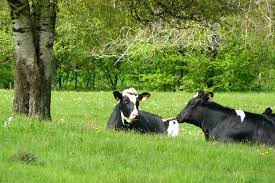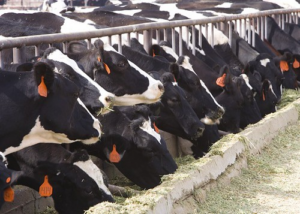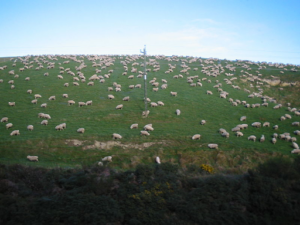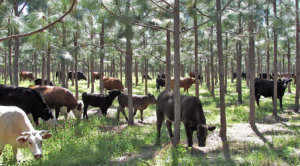Pictured here are two groups of relatively similar cattle who are experiencing drastically different living situations. Briefly imagine life as one of the cows pictured here—where would you rather be living? If you are a beef-consuming individual, which of these sets of cows would you rather eat, or drink milk from?


Very likely, the answer to both questions would be, “Those ones on the left!” Seeing animals in the cramped, miserable conditions pictured on the right is likely disheartening for meat-lovers and meat-free folks alike. Sadly, however, the photo on the right is the more accurate depiction of how most livestock is currently being raised in the United States.
Current agricultural practices are unsustainable and often inhumane
Industrial agriculture and intensive grazing practices are environmentally detrimental on numerous levels. Much of the United States’ livestock production takes place in what are known as Concentrated Animal Feeding Operations, or CAFOs, which are densely populated and associated with very poor animal health and a high usage of growth-promoting hormones and steroids.

Even animals that are lucky enough to be living in grazing systems are often feeding on miles of homogenous grassland with little natural biodiversity (a lack of species variety within an ecosystem) and poor soil quality. Animal welfare and ecological health deteriorate under such conditions, yet they remain the norm in many of the agricultural regions of the United States.
Silvopasture offers a superior alternative to current practices
Silvopasture systems, an agroforestry method which combines grazing land with forests, offer an alternative grazing paradigm with several ecological benefits. This combination of trees and bushes with livestock and grazing land is linked to:
- Increased habitat for pollinators, like bees, and small herbivores and predators. Creating habitat for these critters increases the biodiversity and health of the entire ecosystem!
- Better soil health and less soil erosion, thanks to those handy tree root systems
- A more diverse and nutrient-rich diet for grazing livestock
- Reduced heat stress in livestock, who can shelter in shade from the trees
- Carbon sequestration – trees are much better at removing carbon from the atmosphere and storing it than regular grazing land. Silvopasture systems can create carbon storage areas that are important for climate change resilience, because capturing and removing carbon from the atmosphere helps reduce greenhouse gas emissions and global warming effects!

Could silvopasture offer a sustainable alternative to current livestock cultivation practices in the United States?
Potentially, but certain political and economic hurdles currently stand in the way of widespread silvopasture adoption. Converting to silvopasture systems entails upfront and maintenance costs that can act as barriers for farmers who are interested in implementing these land management systems but cannot afford the financial burdens of doing so.
The United States Department of Agriculture currently offers limited grant funding to help farmers transition to silvopasture and other agroforestry management practices, but there is currently not nearly enough money available for a broad-scale conversion of the agricultural sector.
In addition, there are some powerful oppositional forces that would need to be overcome to shift current agricultural practices. Today, most farms in the U.S. are not the idyllic, small family farms we often picture when thinking of rural American farmland.
In actuality, many farms are large, industrialized operations that are owned or strongly influenced by the major companies that buy their products, like Tyson and Perdue. These corporations and large farming entities have become powerful political actors, with vested interests in maintaining current unsustainable agricultural practices that prioritize profits over environmental, animal and human health.
What can everyday people do to help promote wider adoption of silvopasture?
Unless you’re inclined to uproot and start your own farm, offering political pressure and financial support are likely more feasible options. Advocating for federal political representatives to support increased funding for agroforestry measures in the next Farm Bill, donating to nonprofits that support farmers in undertaking sustainable practices, and trying to buy from farmers who utilize silvopastoral or other agroforestry systems on their properties are all great avenues to support silvopasture implementation.
